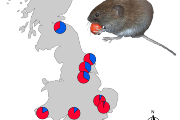
Genetic mixing as a path to survival
02. 09. 2024
In the face of rapidly changing climate conditions, genetic mixing may be a key factor for species survival, enabling critical new adaptations. This is the conclusion of a research study conducted by a team of scientists from the Institute of Animal Physiology and Genetics of the Czech Academy of Sciences (IAPG CAS), in collaboration with colleagues from Oklahoma University and Cornell University in the United States. Their findings could help reshape current approaches to the conservation of endangered species.
Reduced genetic variability often leads to decreased population viability, and in some cases, the extinction of entire species. However, endangered populations can sometimes be “rescued” by genes that come from other populations. “Our results show that genetic mixing can serve as a critical source of genetic diversity, enabling rapid adaptation to changing conditions,” says Petr Kotlík, the leader of the research team from the IAPG CAS. The researchers illustrated this phenomenon with the case of the bank vole in Great Britain. They discovered that the mixing of genes from populations adapted to different climate conditions resulted in a population better equipped to survive in new environments.
Colonizers Bring Genetic Diversity
The bank vole, a common rodent in temperate forests, is an ideal model for studying this process. Its population in Britain arose from two waves of migration from different European refugia after the Ice Age. Each wave of colonizers brought distinct genetic traits, which created new combinations of adaptive characteristics.
“We compared individual genes from this genetic mix and found that key genes related to climate adaptation showed different degrees of mixing compared to other genes. The degree of mixing was either greater, meaning that the more advantageous variant was introduced by later colonizers, or smaller, if the advantageous variant came from the initial colonizers,” explains Michaela Horníková from IAPG CAS, the study’s first author.
Adaptation to post-Ice Age climate change was the driving force behind this genetic mixing. This genetic diversity not only allowed bank voles to adapt to past climate change but also provides them with a “reserve of adaptations” for future climate change.
Genetic Purity Isn’t Always an Advantage
This discovery has significant implications for understanding evolutionary processes and their application in conservation efforts. Traditionally, conservation strategies for endangered species have emphasized maintaining genetic purity to avoid disrupting local adaptations. “However, our findings challenge this notion. They demonstrate that mixing populations adapted to different conditions can be crucial for species survival,” explains Petr Kotlík. Similar genetic mixing can occur not only between populations of the same species but also between different species. “There are known cases where crossbreeding between species has provided evolutionary benefits. For example, humans carry immune system genes from other hominid species, and different species of mice have shared genes that provide resistance to rodenticides,” adds Michaela Horníková.
The findings of this research open up new possibilities for the conservation of endangered species in the context of climate change. One of the strategies being discussed is “assisted adaptation,” which involves creating conditions for isolated populations to come into contact or even moving individuals with desirable genes to new areas. “By understanding how and where species gain genetic diversity and the ability to adapt to new conditions, we can better predict the impacts of climate change and mitigate its effects on the most endangered species,” concludes Petr Kotlík.
Contact:
Petr Kotlík
Institute of Animal Physiology and Genetics CAS
kotlik@iapg.cas.cz
Download the press release here.
Read also
- Matyáš Fendrych Receives ISTA Alumni Award
- Hidden parasites could threaten the health of endangered mountain gorillas
- 90% of mycorrhizal fungal biodiversity hotspots lie outside protected areas
- How lakes connect to groundwater critical for resilience to climate change
- A unique method of rare-earth recycling can strengthen the material independence
- High-energy cosmic rays dominated by heavy METALS
- Genome Tool Developed at CAS Featured in PLoS Genetics
- Why do brain cancer cells steal mitochondria?
- Secrets of the Nano- World: a new comic book about nanotechnology
- Teen duo from Slovakia and Czechia named Global Winner for clean water solution
The Czech Academy of Sciences (the CAS)
The mission of the CAS
The primary mission of the CAS is to conduct research in a broad spectrum of natural, technical and social sciences as well as humanities. This research aims to advance progress of scientific knowledge at the international level, considering, however, the specific needs of the Czech society and the national culture.
President of the CAS
Prof. Eva Zažímalová has started her second term of office in May 2021. She is a respected scientist, and a Professor of Plant Anatomy and Physiology.
She is also a part of GCSA of the EU.

